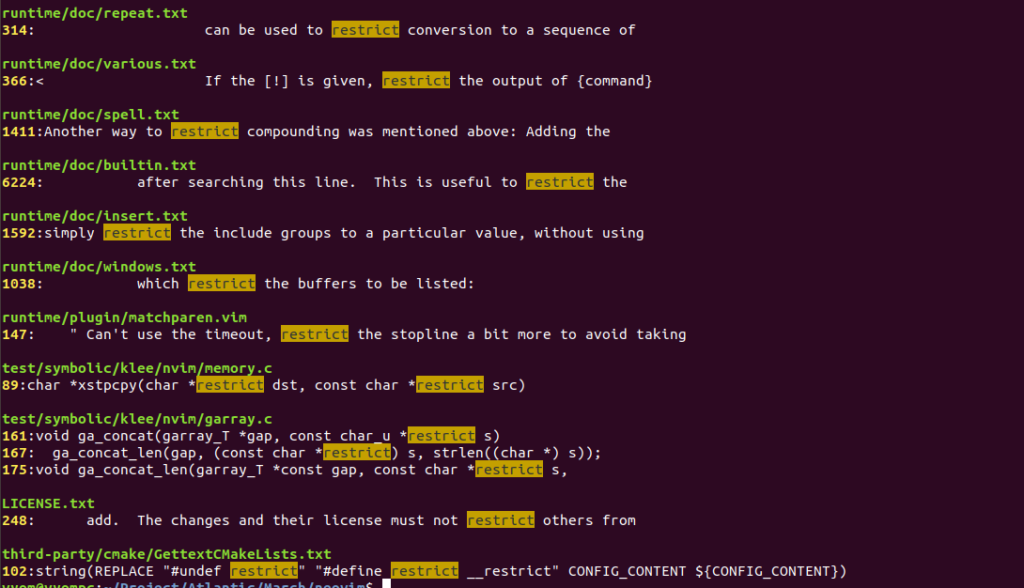Table of Contents
- Install Ack in Linux
- Download Neovim Source Code
- Search for the Total Number of Files in the Directory
- Search for a String Pattern Using Ack Command
- Search for a String Pattern Word Using Ack Command
- Search for a String Pattern from a Specific File Type
- Count the Total Occurrences of a String Search
- Search for a Specific File Type
- Conclusion
Linux operating systems offer support for searching both files and directories for specific text strings. One of the most common tools to search for a text string is grep. Grep allows users to search for any pattern with regular expressions within files and directories. However, grep has some limitations. It is a general-purpose tool without any optimization. This is where the Ack tool can help. The Ack tool is specifically designed for developers for searching the source code of programs. The Ack tool is faster than grep and allows us to exclude certain outputs from search results.
In this post, we will show you how to install and use the Ack command in Linux.
Install Ack in Linux
By default, the Ack tool is included in the default repository of all major operating systems.
For Debian and Ubuntu-based distributions, install the Ack tool using the following command:
apt-get install ack-grep -y
For RHEL, Fedora, and CentOS-based distributions, install the Ack tool using the following command:
dnf install ack-grep -y
After the installation, verify the Ack version using the following command:
ack --version
You will get the following output:
ack 2.22 Running under Perl 5.26.1 at /usr/bin/perl Copyright 2005-2017 Andy Lester. This program is free software. You may modify or distribute it under the terms of the Artistic License v2.0.
Also Read
How to Install LFTP to Download and Upload Files in Linux
Download Neovim Source Code
To demonstrate how to use the Ack command, we will download neovim source code from the Git repository.
Run the following command to download the neovim source:
git clone https://github.com/neovim/neovim.git
Once the download is completed, change the directory to the downloaded source and list all files:
cd neovim ls neovim
You should see all files in the following output:
BACKERS.md CMakeLists.txt CONTRIBUTING.md man scripts third-party BSDmakefile codecov.yml LICENSE.txt packaging snap unicode ci config MAINTAIN.md README.md src cmake contrib Makefile runtime test
Search for the Total Number of Files in the Directory
You can use the Ack command to find out how many files are inside the repository.
ack -f | wc -l
You will get the following result:
2899
Search for a String Pattern Using Ack Command
The Ack command can search for a specific pattern and find data that has either partial or full matches.
For example, to search for the string “restrict” in the repository, run the following command:
ack restrict
You will get the following result:
Also Read
How to Compare Two Files in Linux Terminal
Search for a String Pattern Word Using Ack Command
If you want to see the exact match in the result, use the -w option:
ack -w restrict
You will get the following output:
As you can see, the Ack command searches for restrict as a complete word.
Search for a String Pattern from a Specific File Type
If you want to search for a specific string in a specific file type, including Python, C, or Vim, you can use the –python, –c, or –vim option.
For example, to search for a string “restrict” only within Python files, run the following command:
ack -w --python restrict
You will get the following output:
Count the Total Occurrences of a String Search
If you want to count the total number of occurrences of a specified string, use the -c option with Ack command.
ack -c restrict
You will get the following output:
If you want to show the total number of occurrences of a string “restrict” in the output, run the following command:
ack -ch restrict
You will get the following output:
232
If you want to check the speed of the searches, run the following command:
time ack -ch restrict
You will get the following output:
232 real 0m0.631s user 0m0.551s sys 0m0.076s
Search for a Specific File Type
The Ack command can also find the specific file types from the specified directory.
For example, to find all Python files in your current directory, run the following command:
ack -f --python
You will get all Python files in the following output:
src/clint.py src/nvim/testdir/pyxfile/py2_magic.py src/nvim/testdir/pyxfile/py3_magic.py src/nvim/testdir/pyxfile/py3_shebang.py src/nvim/testdir/pyxfile/pyx.py src/nvim/testdir/pyxfile/py2_shebang.py src/nvim/testdir/test_makeencoding.py contrib/gdb/nvim-gdb-pretty-printers.py contrib/YouCompleteMe/ycm_extra_conf.py scripts/stripdecls.py scripts/gen_help_html.py scripts/check-includes.py scripts/shadacat.py scripts/gen_vimdoc.py
Conclusion
In this post, we explained how to install and use the Ack command in Linux. Ack is a very useful and flexible search tool for developers when handling multiple projects. Get started now on VPS hosting from Atlantic.Net!



